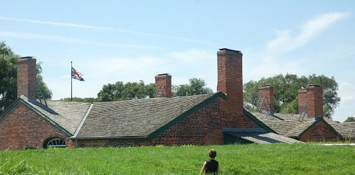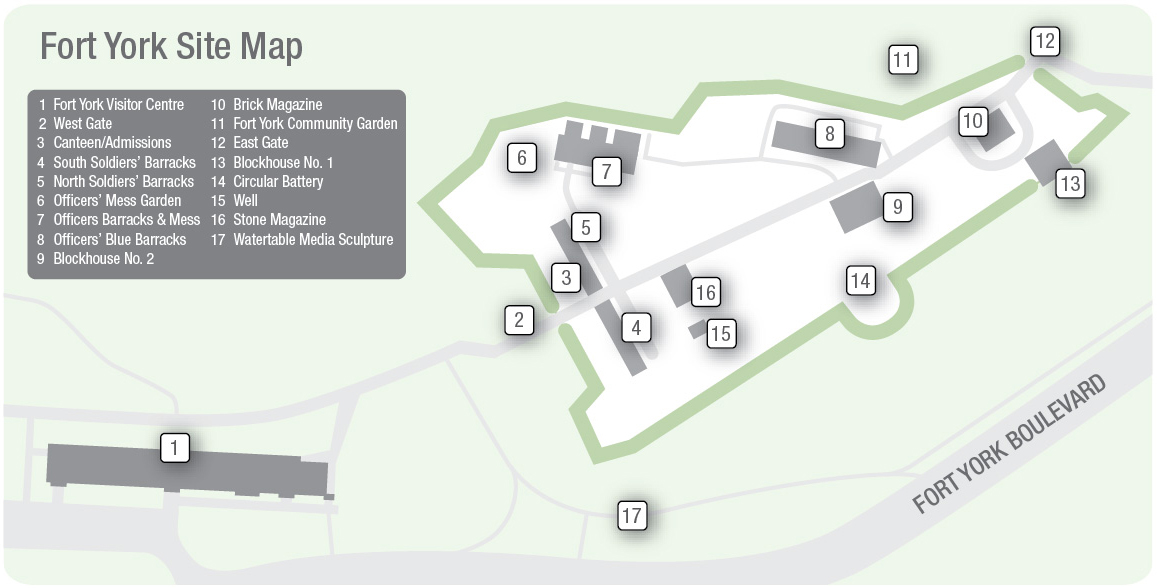|
The Soldiers' Barrack Room–1815 (Map reference #5):
The northernmost room of the North Soldiers' Barracks is presented as typical accommodation for ‘other ranks’ in the British Army and Upper Canadian Militia late in the War of 1812. The room features berths or bunks for 32 soldiers and/or their family members. It is used to interpret the austere, practical army facilities afforded to the lower rank and file for most of the 19th century. (Recreated Environment)
Officers' Mess Kitchen Garden–1815 (Map reference #6):
The Officers’ Mess Kitchen Garden was established in the northwest bastion in May of 2010 through a partnership between of City of Toronto staff, the Evergreen Foundation, and The Friends of Fort York and Garrison Common. It contains eight raised beds that reflect the gardening practice of the Georgian period and also conserve the archaeological remains of the Rebellion Barracks that occupied this location between 1838 and ca. 1932.
It is modelled on gardens used by the military to supply fresh produce to the men in garrison. The heirloom vegetables and sweet herbs are grown using organic gardening principles and are used to enhance the Food History Programme at Fort York and special events such as the Conscious Food Festival and the recent Georgian Mess fundraising dinner in honour of Major General Isaac Brock. Volunteers have planted the garden and helped to maintain it since 2010, under the direction of senior program officer Bridget Wranich, so that another dimension of garrison life can be interpreted at the fort. To read more about the garden, please consult the Winter 2010 issue of The Fife and Drum (Volume 14, No.4). (Recreated Environment)
The Officers’ Brick Barracks and Mess Establishment (Map reference #7):
Though built in 1815, the Officers’ Brick Barracks has been restored to its 1830s appearance. The building is the most complex on site and features a series of purpose-built rooms which include an Officer’s Bedroom and Sitting room, Mess Dining Room and Ante Room, Mess Kitchen and Servant’s (day) Kitchen, Pantries, Mess Man’s Room and Plate Room. The 1826 Officers’ Mess Kitchen is a working 19th-century workspace with functioning down hearth and bake oven cooking system. (Recreated Environment)
1815 Kitchen and Archaeology Exhibit (Map reference #7):
The cellar of the 1815 Officers’ Brick Barracks houses the oldest surviving kitchen in Toronto, a storage/wine cellar and two fire-proof money vaults that date to the Upper Canada Rebellion era. This fascinating exhibit features exposed archaeological features such as original drainage systems. Archaeologists recovered over 12,000 artefacts from this space between 1987–1990.
Archaeology: The Search for History Beneath our Feet (Map reference #8):
The Blue Barracks features a fascinating archaeology exhibit. A series of panels and artefacts take the visitor through the process of excavation and laboratory analysis, to conservation and display of artefacts. Objects recovered from the 1987 excavation of Fort York’s Officers’ Mess are on display. They range from small military finds to rare pottery, buttons, bottles, and personal items. (Reconstructed Blue Barracks and Mess)
Fort Toronto 1750–59 and The Fur Trade (Map reference #8):
Exhibit panels and displays of original artefacts and reproductions chronicle Toronto’s role in the 18th-century Great Lakes region fur trade and role played by the nearby French Fort Toronto (Rouille). (Reconstructed Blue Barracks and Mess)
War on the Lakes (Map reference #8):
Exhibit panels, original objects, and models deal with the growth and use of naval power on the Great Lakes. An accurate scale model of the USS Scourge, an armed schooner pressed into service during the War of 1812 which subsequently sunk in 1813, is on display. The model presents the vessel’s current appearance resting on the floor of Lake Ontario some 100 m below the surface. This model is displayed courtesy of the Ontario Science Centre. (Reconstructed Blue Barracks and Mess)
HMS Nancy Display Case (Map reference #8):
On exhibit is a highly-detailed, 1/16 scale model of HMS Nancy built by Toronto marine historian C.H.J. Snider (1879-1971). The original HMS Nancy was laid down at the British post of Detroit in 1798 and served the Provincial Marine and Royal Navy as supply vessel for the Upper Lakes during the War of 1812. She was burned on the Nottawasaga River during an American attack in 1814. The model is constructed of original materials recovered from the vessel wreck that include original white oak, red cedar, and molten lead. (Reconstructed Blue Barracks and Mess)
The Soldier's Trade – Exhibit: 1793–1870 (Map reference #9):
The British Army garrisoned Toronto from 1793 to 1870. During that time it evolved in fundamental conformity to the developments in other western armies. The exhibit explores British military technology and practices in Canada in the fields of artillery, engineering, cavalry, command, infantry, medicine, and music.
The exhibit is a rich and graphic presentation of original and reproduction military objects which include uniforms, weapons, headgear, artillery, tools, musical instruments, and archaeological material. Large scale dioramas show the fort and associated defences in relation to the Town of York (Toronto) and its position on Toronto Bay as the city’s primary harbour defence. Featured objects include two large cannon used by York’s defenders during the Battle of York on 27 April 1813. One is an extremely rare form of British ordnance cast in between 1656–58 for the army of Oliver Cromwell. It is one of only two known to exist.
The Soldier's Trade occupies the upper and lower floors of Blockhouse Number 2, built in 1813 as a 160-man barracks and fortified structure. It was among the first army buildings to be constructed after the American attack on York.
Watertable (Map reference #17): Due to on-site construction, the 'Watertable' exhibit has been temporarily removed.
Watertable is a media sculpture that uses the architecture of the Gardiner Expressway to echo the natural condition of the site where it marked the water's edge in the early days of the city's history. A light and sound experience, Watertable incorporates LED lights to simulate wave patterns which are triggered by actual wind conditions. The accompanying sound of the waves making landfall completes the experience. Winners of the 2005 Governor General's Award in Visual and Media Arts, Lisa Steele and Kim Tomczak developed Watertable as part of an international open competition held in 2007. Visit https://vimeo.com/46426272 to view a video of Watertable.
|




